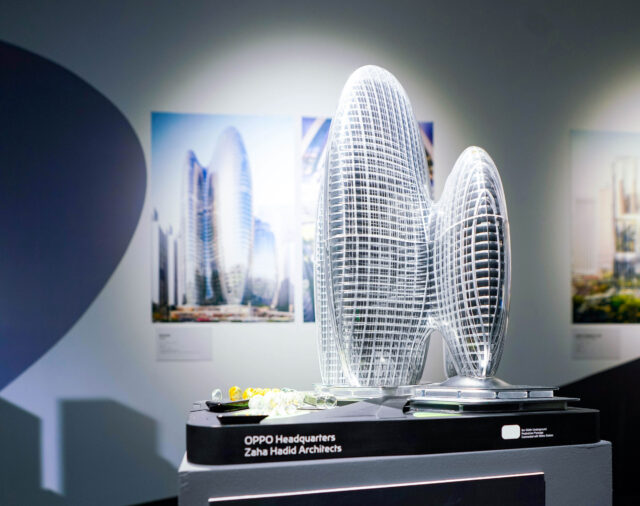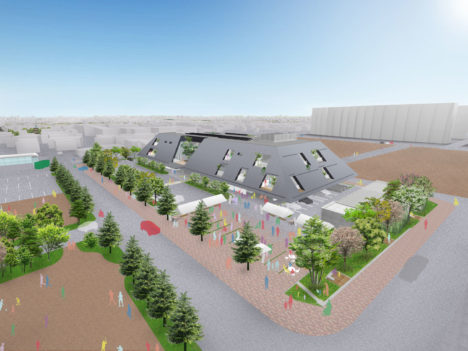SHARE “Rethinking the New National Stadium of Japan by Zaha Hadid” by Arata Isozaki
*Japanese architect Arata Isozaki delivered this text about Zaha’s New National Stadium of Japan to news media on November 5 2014. Architecturephoto.net intoroduces all text by Isozaki.
Rethinking the New National Stadium of Japan by Zaha Hadid
Arata Isozaki
Two years ago, I felt that the Zaha Hadid proposal chosen through an international competition was a design that presented an excellent image of a 21st century urban architecture, calling to mind the sense of speed of sports competitions. As a resident of Tokyo, I supported the proposal.
However, when I saw the revised proposal that has been presented in detail at the Zaha Hadid exhibition (Tokyo Opera City Art Gallery), I was shocked to see that the dynamism present in the original had gone. What remains is a dull, slow form, like a turtle waiting for Japan to sink so that it can swim away. The sight left me in despair. If the stadium gets built the way it is, Tokyo will surely be burdened with a gigantic white elephant.
I have heard that this revised proposal was made by incorporating the various opinions voiced by different parties after the competition selection was announced, as well as the results of the assessment for constructability, program and budget reviews, and so on. It is quite normal for a project to handle environmental concerns, restructuring of overloaded programs, compliance with an appropriate budget and many other issues. Such steps have to be taken during the process of creating any important public facility. These are just an ordinary part of the job for a professional architect. In spite of this, the revised proposal seems to be turning the stadium into something that will not satisfy people on either side of the discussion about the original proposal. At first, I had no doubt that all the parties concerned were seeking for a design that we can all be proud of in the history of the Olympics. But I was wrong.
The process has been distorted.
As an architect, I have been involved in numerous international competitions as a judge and as a competitor. I have been chosen through international competitions as the designer of major sports facilities such as the Palau Sant Jordi for the 1992 25th Summer Olympics (Barcelona), and the Palasport Olimpico (Palaisozaki) for the 2006 20th Winter Olympics (Turin), and I have experienced the subsequent construction process. From that position, I am particularly concerned with the way the New National Stadium design is being handled at present.
Various opinions as to what to do next are being aired in public. Let me summarize the main points here.
1. Respect the fact that the Zaha Hadid proposal was chosen through the legitimate process of an international competition.
2. Acknowledge as reasonable the criticism by experts, architects, and the public that the original proposal is unsuitable to the environment of Jingu Gaien.
3. Accept that expectations were overblown and that the resulting design greatly exceeded the appropriate budget because the conditions given to the architects in the international competition included an overloaded program.
4. Do not renege on the international commitment implied by the use of the image of the New National Stadium as the centerpiece of the Olympic bid in both the international competition proceedings and in the media.
These points are not my personal opinion. They simply represent views aired in the media, and they contradict each other. If this situation proceeds unchecked, the people playing a leading role in this debate will all share the responsibility for a result that will remain a disgrace to future generations. As an architect who has experienced similar circumstances internationally, I would like to give my suggestions for how the situation could be handled.
A. Do not use the stadium for the Olympic opening ceremony, which is only a temporary event. Instead, concentrate on creating a sustainable stadium at the present location. Construct a sports field that meets the standards for an Olympic stadium, and also incorporate facilities designed for its continued use after the Olympics and Paralympics. Pay close attention to forming the landscape while taking into consideration the surrounding environment, including the flow of large numbers of visitors.
B. Hold the 2020 Tokyo Olympic opening ceremony at a purpose-built venue outside the Imperial Palace moat in front of the Nijubashi Bridge. This is an opportunity to surpass the format of a opening ceremony on the main athletic field that has been standard ever since the 1936 Berlin Olympics. Such a stage could capitalize on being live for the media age, addressing the 1 billion people watching on TV or online, not just the 100,000 or so people at the venue.
At that location, there is room to erect a three-dimensional grandstand facing a spacious stage larger than an athletic field against the backdrop of the Edo Castle moat, stone walls, and keep. The grandstand could accommodate around 120,000 people. Afterwards, it could be dismantled into 50 parts for relocation to each of Japan’s prefectures, contributing to the creation of parks or stadiums throughout Japan to commemorate the Olympics. Images of the opening ceremony from cameras soaring through the sky and from every other angle can be broadcast to the entire world.
C. Respect the result of the international competition. There are two main ways to interpret a competition decision: The first is to select the proposal. Implement the proposal as-is in its original form. (Judges evaluate the physical form of the proposal, with the architect unknown.) The second way is to select the architect, who created the proposal. (Judges evaluate the potential of the architect.) In the second case, when there are changes to the program, the architect will be the creator of a new proposal conforming to the conditions.
The reason that the New National Stadium proposal is straying off course is because of the insistence on selecting the proposal. This leaves the organizers falling into a trap of their own making. Considering the type of project, the competition should have been selecting the architect as a matter of course. The concerned parties somehow believe that it was only the proposal that was selected, despite its clear Zaha Hadid signature. Ignorance of the conventions of international competitions, lack of understanding, and irresponsible decisions have consequently distorted the subsequent process.
In the Olympic facilities that I have been involved in, it has always been the architect that was selected. When new conditions arose, I dealt with them while further adding on new ideas, and was able to engage with the project from the final design to the management stage. A professional architect should be able to flexibly respond to changing situations. The current winner, Zaha Hadid, is an architect whose talent I discovered 30 years ago and who I have worked with several times thereafter. Her professional skills are outstanding. No matter how difficult the situation, with personal, active participation she is capable of leaving her signature on the design. However, not even a glimpse of that can be seen in the current revised proposal. I have to say that a monumental mistake has been committed.
It is not too late. Return to the winning decision (an international commitment) and consider the two years of discussions for and against it as a review study of the program. Commission Zaha Hadid to re-design the New National Stadium under these new conditions. She is an architect who is eminently capable of responding in such a manner.
In addition, commission the design of an Olympic opening ceremony venue appropriate for the program to Kazuyo Sejima, the creator of the SANAA proposal that remained in contention through to the end of the competition. The handling of the opening ceremony venue should be the responsibility of the promoters of the 2020 Tokyo Olympics.
By taking this route, we can present an event to the rest of the world that is unconstrained by the traditional size of an arena, against a backdrop of scenery that represents the heart of Japan, not just Tokyo. By doing so, we can create a new format for the Olympics of the 21st century, here in Tokyo.
Arata Isozaki, an architect, was born in 1931 in Oita City, Japan. In 1963 he founded Arata Isozaki & Associates and his works include The Museum of Modern Art, Gunma(1974), The Museum of Contemporary Art, Los Angeles(1986), Sant-Jordi Sports Palace, Barcelona(1990), Turin Ice Hockey Stadium, Turin(1995), Shenzhen Cultural Center, Shenzhen(2007), Beijing Central Academy of Fine Arts, Art Museum, Beijing(2008), Qatar National Convention Center, Doha(2011), Shanghai Symphony Orchestra Hall, Shanghai(2014). He is currently working on a Master Plan of Zhengzhou sub-CBD, Master Plan of East Zhengzhou New District Transportation Hub, etc.


![サムネイル:山﨑健太郎デザインワークショップが千葉県佐倉市の保育園「風のみち、雨のみち / はくすい保育園」の内覧会を開催[2014/11/24]](https://d6pmnsnqga8dz.cloudfront.net/wp/wp-content/uploads/2014/11/yamazaki-open-house.jpg)

